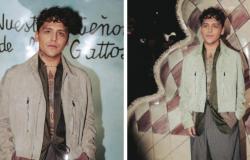The void that the religious images and carvings left on the altar of the old convent of Santa Catalina has become a jungle where the protagonists are nature and destruction. …
Seven and a half meters high, this contemporary altarpiece by Lacalle presides over ‘Desterrados’. This is the name of the collection of large-format canvases with which the artist aims to show the relationship that exists between humans and nature. «The triptych reveals a jungle in which he shows life, through nature, and destruction. Always promoted by men in this case through war,” explains the curator of the exhibition Julián Mesa.
A collection that uses nature to talk about the human footprint, and how it destroys everything in its path. “Man’s footprint appears in all the paintings throughout the landscape, which changes as natural resources are exhausted,” explains Abraham Lacalle to HOY.
The artist makes it clear that this collection, made up of eight canvases, is not an environmentalist claim. “I look more for the analysis of the relationship that man has with the hostile world, relationships with the outside world mark the culture and what we are,” he says.
In his analysis of the landscape, not only the elements he uses become important, the color palette he uses also adds meaning to his work. A bright color gives strength to the natural. The trees, rivers and jungles that the artist recreates with his brush capture the eyes of all visitors, who get lost in the pink, green and blue tones that are the protagonists among the conventual sobriety.
Julián Mesa is the curator of the exhibition and gives guided tours on Saturdays.
C. Moreno
In an evocation of the author’s childhood in Extremadura, his father is from Trujillo, the pastures are one of the landscapes that are most repeated in his canvases. “I have seen corkage since I was little and it impresses me quite a bit because it is like a skinning that evokes freedom and shows that nature surpasses human intervention,” says Lacalle.
The pastures, rivers, jungles and mountains that Lacalle has captured with his brush have arrived in Badajoz after having formed part of the walls of the Museo Nacional Centro de Arte Reina Sofía in Madrid or the House of Velázquez.
His brushstrokes have made him one of the greatest exponents of contemporary art, influenced by German expressionism.
Mastery of techniques is what has made him one of the most important painters of today, “in fact he is one of the few Spanish artists who has been in the Marlborough gallery in New York, which has been one of the main places of contemporary art in the world.
Sarcasm
The color of his work has little to do with realism, at least that’s what Gema Andújar and Yerai Ruiz, two of the visitors who visited the exhibition a few days ago, thought. «We are visiting Badajoz and we did not expect at all to find something like this. The color is fascinating, very happy and very lively,” pointed out Andújar.
Some tones that in many cases are not the usual ones in nature but that add sarcasm to the work. «Color has a lot to say. Lacalle uses unusual ranges, which makes his work sarcastic because he assumes that nature has an order that he alters by painting a blue trunk or a pink horse,” emphasizes Julián Mesa.
To give importance to the color range, the relationship between the space and the canvases is important. For this reason, Mesa has taken care to illuminate the space a lot. “This way we get the colors to bounce and the focus is on the work and not on the sgraffito on the walls.”
The Santa Catalina spotlights make the canvases hanging on its walls shine even brighter, where the human presence is only explicitly manifested in one of them. The ‘Tightrope walker’ is the name of the only painting in which the protagonist is not the landscape and which refers to one of the characters in Zaratrusta’s books. “In his canvases he reflects his experiences, the books he reads, the music he listens to or his own experiences.”
«My painting reflects the relationships that man has with the hostile world»
A work that aims to be a call to attention to the behaviors that society has with nature. At the doors of the Santa Catalina cultural space, visitors leave impressed. A green jungle, converted into an altar, speaks to them of destruction and beauty. “It’s a metaphor, man destroys what he sees not only with wars, but also in his daily life,” reflects Yeray Ruiz after his visit.





